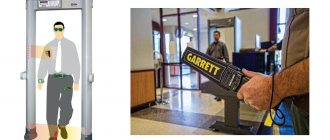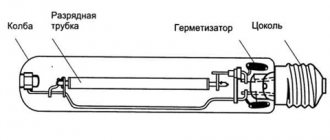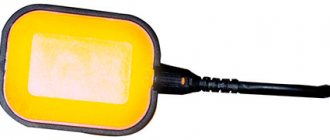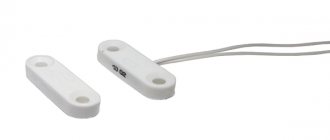It is easy to guess that a metal detector - MI - or a metal detector - MD - is needed in order to detect metal. In the ground, under water, in a wall, on the body or even in the human body. Let's try to figure out how a metal detector works.
A little history. In 1881, the outright psycho Charles Guiteau shot US President James Garfield in the back with a Bulldog revolver. Garfield would have survived the wound quite well if the bullet had been found and removed in time. Doctors tried to feel it with their fingers, but to no avail.
The well-known inventor of the telephone, Alexander Bell, brought his metal detector to Garfield's bedside. However, the search for the bullet was not crowned with success - in the confusion, it never occurred to anyone to replace the iron bed with a wooden one. Bell's metal detector gave constant detection of a large mass of ferrous metal, without noticing a relatively small revolver bullet. Garfield was not saved, and Bell's metal detector was forgotten.
With the advent of anti-personnel and anti-tank - that is, land - mines, the need to detect them forced the military to strain engineers, and they produced instruments that could detect the metal casings of deadly bombs. Before this, the only mine detector was a probe - a sharpened cleaning rod tied to a mop handle. The sapper relied on his instincts and attentiveness - uncharacteristic irregularities, traces of turf removal and other mine-explosive tricks.
Read also: Detailed article about war searches, equipment recommendations, review of finds, features of the dig
Types of metal detectors
By purpose
Depending on where we are looking for metal, MDs are divided into:
- ground;
- underwater;
- inspection
Many use pinpointers as a separate purpose - metal detectors for accurately detecting small targets. But an inspection metal detector and many underwater detectors are the essence of pinpointers.
By signal processing method
MDs are divided into analog and digital. The latter are clearly more progressive, but until recently they were not distinguished by their speed - the search detector had already passed over the target, and the metal detector had just responded. Modern digital metal detectors do not allow this to happen; they emit a sound signal and display vDI (visual discrimination indicator) on time. Glory to work, both the element base and firmware have recently stepped forward quite far.
An analog metal detector has a number of disadvantages compared to a digital one. In particular, only consistent discrimination, poor sound indication, almost no visualization of digging signals.
Read also: Garrett Pro-Pointer AT: characteristics, tests, comparison with other models, owner reviews
Operating principle
Metal detector Terminator 3
The generator, together with the induction coil, creates a directed electromagnetic field of a certain shape. The entry of foreign objects into the work area changes the current strength in a closed circuit. This phenomenon is detected by the receiver. The greatest field disturbances are caused by objects with conductive and ferromagnetic properties.
In the processing unit, extraneous noise is eliminated and useful signals are isolated. They are then sent to display devices. The settings elements set the sensitivity and other parameters of the detector.
The basic principle of operation of a metal detector
All metal detectors work approximately the same. They emit and register. They emit electromagnetic waves. And either their disturbance or the reflected signal is recorded.
Inspection metal detectors create eddy currents and record their disturbance. And the disturbance of strict eddy currents is caused by metal objects. Pinpointers and small underwater metal detectors work exactly the same way.
Ground metal detectors can be built according to several schemes or principles.
Transmitter-receiver
The first and most common is TR or VLF. This principle of operation of a metal detector is based on the emission of a wave of a certain frequency by one antenna and the reception of the reflected signal by another. The frequency of such metal detectors is not very high, which is reflected in the name. VLF stands for Very Low Frequency or Very Low Frequency.
The operating principle of a VLF/TR metal detector is similar to the operating principle of an echo sounder. They emitted a signal at one point in space and received it at another. This is why you need to wave a metal detector.
The receiving and transmitting antennas can be located, for example, one inside the other, forming circles with a common center, that is, concentric. And the coil is also called concentric. Another common coil type is DoubleD. Two elliptical frames are offset along the short side.
It is not at all necessary that a VLF metal detector is a coil. There are other constructs. For example, like White's TM 808 - the receiving and transmitting antennas are spaced apart, so you don't have to wave them.
Such metal detectors can distinguish metals under the coil. Depending on the targets under the coil, the nature of the “response” changes. By analyzing different characteristics of the response signal, metal detectors distinguish targets based on either metal conductivity or inductive properties.
Therefore, if you come across the term IB - this is the balance of induction - do not let it confuse you. This is not a method of detection, but a method of discrimination. By the way, there are devices that analyze both conductivity and inductance. This is, for example, the famous “tractor” - Minelab E-Trac.
Conductivity analysis does not have a separate, established abbreviation.
VLF metal detectors see a coin - for example, a Soviet nickel - at a depth of 20-30 centimeters in the ground. Outstanding models can detect coins deeper. For example, the Polish Rutus Alter 71 is guaranteed to catch a nickel from a depth of 35 cm. And it happens that it finds it even deeper.
Pulse Induction
The operating principle of a PI or Pulse Induction metal detector is the emission of a single pulse and analysis of the response from it. But this analysis occurs with a frequency of hundreds to tens of thousands of times per second. By the way, in Russian this technology is called pulsed.
Pulse MDs have one antenna - it is both receiving and transmitting. There is no need to wave such a metal detector. But when working with a wiring coil, they make it possible to search over a wider band. But the frames are simply worn.
Pulsers do not distinguish metals well. Almost nothing. But they penetrate a much thicker layer of soil compared to VLF. PI is one of the schemes by which deep metal detectors are built. You can also dig for coins, but it’s unlikely that an impulse reader will be able to distinguish a coin from a beer cap. Therefore, with pulse generators they dig pits on battlefields, looking for cannonballs, helmets and other fairly large military relics at depths of half a meter.
Read also: Minelab Excalibur II: features, capabilities, tests, examples of finds, owner reviews
Radio Frequency
Another metal detector that does not need to be waved is a device built on the RF principle. The design of the metal detector is, on the one hand, banal, on the other hand, it is original - it always has two antennas. But the transmitting one is oriented parallel to the ground. And the receiving one must be at least a meter away from the transmitting one and located perpendicular to the ground.
You just need to look at the Fisher Gemini 3 to understand how different it is from the same Garrett Ace 250. The difference is especially visible when, for example, routing pipelines, which is done together, when the receiving and transmitting antennas are moved separately from each other.
The RF metal detector does not see small metal debris. He does not distinguish between metals - both iron and gold ring the same. But it can find a water pipe at a depth of 3 meters. Or a plane in a swamp. Or a metal stove-stove in a long-buried dugout. Or a well. Or a tunnel - in general, they don’t dig coins with it, it has other tasks.
Assembly of the “butterfly”
Let's look at how to make a homemade butterfly metal detector. The device received this name due to the presence of two inductors resembling butterfly wings. The correct operation of the device depends primarily on the functioning of the two generators, which operate at the same frequency after connecting the two above-mentioned coils to them. The field balance of such a metal detector is disrupted when foreign conductive objects enter it.
The coils in the diagram are designated L1 and L2, respectively; they are made of wire with a cross-section from 0.5 mm2 to 0.7 mm2. If you can find a varnished transformer copper winding core, this will be the most acceptable option for assembly.
To make coils, the wire is wound so that each has 30 turns, and the diameter of such a product is 19 cm. Mounting thread and filling with transformer varnish will help to make the wound coils monolithic. If this procedure is not carried out, the coils will vibrate too much and throw off the balance of the device.
How a “butterfly” works Source profazu.ru
To make a butterfly metal detector, in the second stage you need to assemble a board according to the above diagram. To do this, you must first etch it according to the following drawing.
Drawing for etching the board Source profazu.ru
The power source for the butterfly metal detector can be a rechargeable acid battery (ACB) on an uninterruptible power supply or a unit assembled from AAA batteries. It is enough to set the voltage at the level of 9-112 Volts.
After completing work on the circuit and assembling the device, you should start setting it up. This process must be done by adjusting three resistors, which are designated by the letter R. The first of them helps to achieve balance by working with the frequency of the generator, the second and third adjust the sensitivity of the finder more accurately.
To configure the assembled simple metal detector, you need to set all three resistors to the middle position. The coils must be positioned in the shape of the infinity sign or the number “eight” lying on its side, gradually moving them to the sides or towards each other, thereby ensuring that synchronization is disrupted. As soon as the squeak of the device becomes a crackling sound, you should stop. In this case, the rings need to be fixed using a piece of plywood on which the coils are fixed.
Using a homemade metal detector you can find interesting things Source vrtp.ru
Next, turn resistor No. 1 until a stable crackling sound appears at even intervals. After this, various metal objects are brought to the intersection of the coils and the second resistor is twisted, achieving a stable thin sound or squeak. At the final stage of adjustment, the most sensitive resistor No. 3 is used. After the microcircuits are hidden in the junction box and all the parts are attached to the rod, you can check the device in action.
By the way! You can use any other plastic box of the required size as a junction box.
See also: Catalog of construction companies that have their own production of materials and components for the construction of houses
Metal detector frequency range
Metal detectors have a search frequency—the search detector operates on it. The editors have already discussed this issue in a separate article. The operating frequencies of VLF devices literally start at 1 kHz. And they end, for example, at 100 kHz.
But there were only isolated mentions of the frequency of the sound that the metal detector makes. Recall that the human ear perceives frequencies from 20 Hz to 20 kHz, plus or minus.
An analog device smoothly changes the sound frequency depending on the nature of the target - this is how design engineers usually configure the circuit. Digital sounds are stitched into segments of the discrimination scale, or there is polyphony - this is when each VDI sounds with its own tone.
Advanced digital devices allow you to customize the audio response by segment of the discrimination scale. The treasure hunter can only listen to pleasant sounds, avoiding the “irritating” ones. Some digital MDs allow you to separately adjust the response to hardware not only in frequency, but also in volume. This metal detector sound is called Iron Audio.
Read also: Minelab E-trac: detailed review, reviews, comparison with competitors, tests with video
Basic equipment of the metal detector
Typically, the basic equipment of both a car and a metal detector includes only those things without which operation is impossible. For an ordinary conventional TR ground metal detector this is:
- Control block;
- barbell;
- reel with cable and fasteners.
This is a set with which you can already walk. Armrests are also often included in the basic package if they are a structural part of the bar. There may be MDs without armrests - for example, Bounty Hunter Junior. Batteries or batteries, if they are of standard size, are often not included in the basic package.
Basic equipment also depends on the level and status of the model. For example, Rutus metal detectors clearly demonstrate this. The younger Ultima model has almost no special stages, while the middle one - Argo - has much more of them. And the eldest - Alter 71 - was sprinkled with a generous hand. There are covers, and training jackets, and a “hernia” type bag - in general, the treasure hunter is equipped.
“Pro” type packages still usually contain some additional equipment - headphones, coils, pinpointer.
Metal detector modifications
Progress does not stand still. And metal detectors are also developing, they have new functions.
Many digital devices have the ability to flash - that is, update the firmware. The control unit loads a new program into itself and improves its functionality, adds new search programs and modes, and provides even greater possibilities for controlling the metal detector hardware.
Handicraft and homemade metal detectors are often subject to modifications. Especially those whose diagrams are posted on the Internet, as well as programs. Any knowledgeable radio amateur can take them as a basis and modify them in accordance with his inner beliefs.
We should also highlight the tuning of production models. Usually it runs out on new reels, including alternative manufacturers - Nel, MarsMD, Detech. But there are also those who like to tinker with the scheme. For example, attach a regulator to the same ICQs that squeal like victims at a constant volume.
Read also: AKA Sorex: features, capabilities, tests with videos, examples of finds and reviews from owners
DIY Terminator 3
If you need a homemade metal detector with metal discrimination, pay attention to this model. The scheme is quite complicated, but your efforts pay off with the coins you find, which may turn out to be gold.
The peculiarity of the “Terminator” is the separation of the receiving and transmitting coils. A 200 mm ring is made to emit the signal. 30 turns of wire are laid for it, then it is cut, as a result we get 2 half-coils with a total capacity of 60 turns (see diagram).
The receiving coil is located inside, 48 turns with a diameter of 100 mm.
The adjustment is made using an oscilloscope; after achieving optimal amplitude results, the windings are fixed in the housing by pouring epoxy resin.
Then an experimental hands-on adjustment of the discrimination switch is performed. For this, real objects made of various metals are used, and their type is marked on the mode switch (after verification).
Radio amateurs are working on an improved version of Terminator 4, but there is no practical copy yet.
Advantages and disadvantages of metal detectors
There are no universal metal detectors. Which are equally good at searching for planes sunk in swamps and small nuggets of gold. What is a virtue for some - for example, finding metal coins for a coin coin - is good, is not necessary for others. For example, there is no need for a depth explorer to discover small things. He does not “see” objects smaller than, for example, a tin can.
Generally speaking, any parameter of a metal detector is a double-edged sword and it is important to find the right balance. For example, excessive sensitivity results in false positives. Increased search depth means battery consumption. Moreover, the attenuation of the wave occurs along the cube of the distance, which means, conventionally speaking, to double the depth, you need to increase the power of the emitter by 8 times.
But there are also disadvantages, the only compensation for which is the price. These, for example, include the lack of ground balance. A metal detector once set to some average soil will give false alarms on highly mineralized soils. And miss targets in low-mineralized ones.
Video description
The following video clearly shows how to make a metal detector:
- Bring the homemade device to any metal object and open its doors slightly until you hear the same sound, but very quiet. If this happens, the metal detector is working correctly. All that remains is to fix the two flaps of the CD box in the found position (for this, foam inserts, supports and elastic bands are used).
By the way, there is no need to talk about how to make a metal detector from a magnet. To search for metal objects using this method, you just need to get a good neodymium magnet. When it approaches the location of the expected location of the things you are looking for, you will immediately feel the action of an attractive force, that is, the hand with the magnet will be physically pulled to the ground or to another place where the metal object is located. It is immediately clear that a neodymium magnet is the simplest metal detector.
How to set up a metal detector
The metal detector settings depend on the purpose of the search. Typically, the following parameters are configured for a metal detector:
- discrimination;
- sensitivity;
- ground balance;
- threshold sound or threshold;
- frequency - not for all metal detectors;
- audio response.
Search programs for digital metal detectors allow you to reduce setup time. Because the program is setting exactly the same parameters as manually, with the press of one button. The settings in the program were made by experienced engineers. The digger performs additional fine tuning independently.
Let's take a closer look at frequency. To select the frequency, sometimes you need to change the coil. For example, this is how “graters” work—the famous Minelab X-terra 705 and its younger sisters.
Other metal detectors, for example, the already familiar Rutus Alter 71, allow you to change the frequency in the range from 4.4 to 18.4 kHz in steps of 0.2 kHz without any replacement of the coil.
Read also: Rutus Ultima: detailed review, comparison with other models, tests, finds, reviews
Types of metal detectors
DIY metal detector
Products in this category are divided according to their intended purpose and other important characteristics into the following groups:
- ground (standard and deep);
- underwater – with reliable sealing of electronic components;
- discriminators – detectors that provide selective search;
- highly specialized models for searching for precious metals;
- security and military;
- industrial series – designed to control individual technological operations.
What do metal detecting enthusiasts find?
Usually treasure hunters find what they look for. As the Kopars themselves say, “we are looking for war” or “we are digging for coins.” But, of course, the metal detector does not read the owner’s thoughts, but reacts to any metal under the coil, except that excluded by the user.
So, there is a certain layer of users who live by selling scrap. For them, a metal detector is a tool for making money. Since Soviet times, in the fields, on the sites of villages, machine and tractor stations, and other national economic facilities, there have been simply deposits of ferrous metal.
The Metal Digger channel clearly shows how to dig up half a ton of scrap metal. Let's see.
Many lovers of instrument search purposefully hunt for coins and antiques. First, archives are excavated, the locations of former settlements, fairs and markets are determined, and then soil is excavated in their place. A reasonable question arises: is it legal to use a metal detector and then appropriate relics raised from the ground? The answer is in our article Law on Metal Detectors 2022 in Russia.
Here, for example, is the video of the channel In Search of Rarities and Treasures. A whole handful of coins - “tired” councils and a quite vigorous empire - and Nikolai’s pennies and Alexander’s money and much more interesting things.
It would be worth reading this article for fans of “war cops.” We will also recommend to them the latest video by comrade Helmut Weisswald.
If you are not embarrassed by some of the pompous speech and moralizing of the presenter, the channel is very informative, there are simply tons of videos of military excavations.
For each direction of instrumental search on the Internet there is a lot of useful and useless information, videos, guides - I don’t want to dig. The main thing to remember is the legal aspects.











